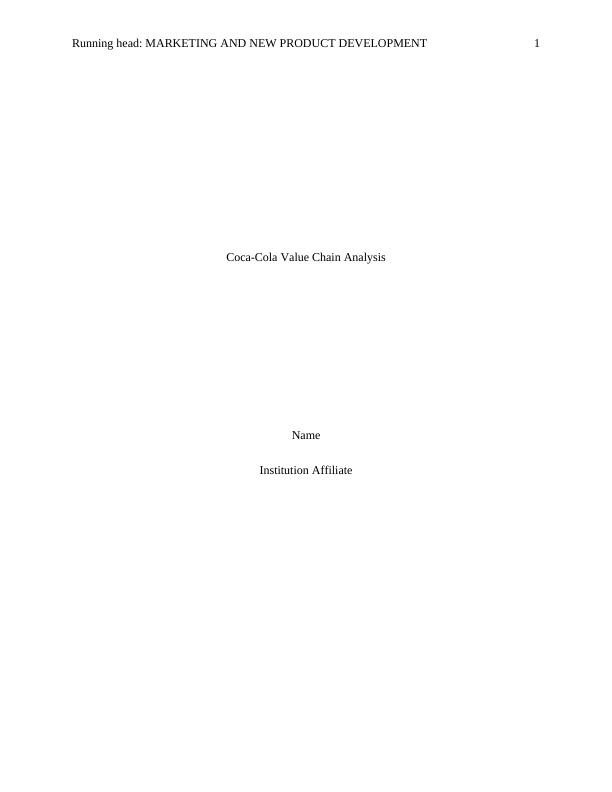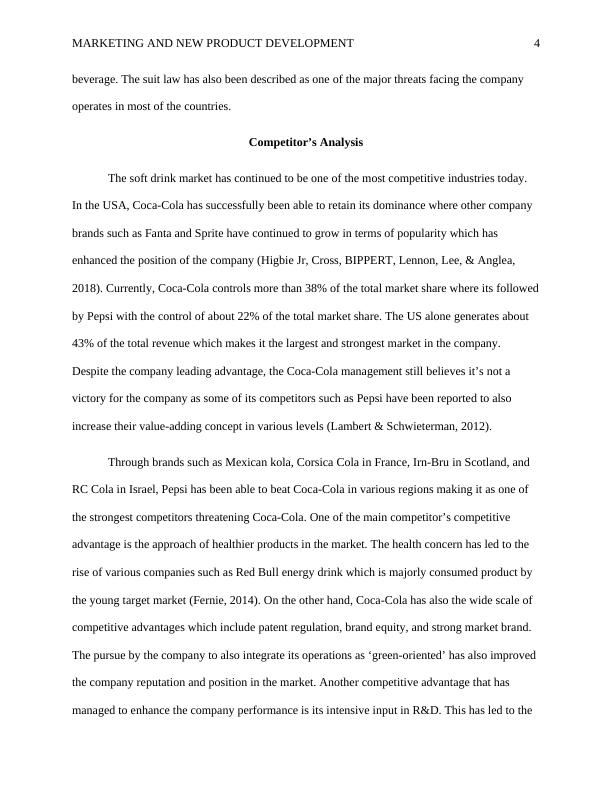Coca-Cola Value Chain Analysis
Added on 2023-06-03
11 Pages3130 Words393 Views
Running head: MARKETING AND NEW PRODUCT DEVELOPMENT 1
Coca-Cola Value Chain Analysis
Name
Institution Affiliate
Coca-Cola Value Chain Analysis
Name
Institution Affiliate

MARKETING AND NEW PRODUCT DEVELOPMENT 2
Coca-Cola Value Chain Analysis
Introduction
Coca-Cola company is one of the largest beverage companies all around the world. The
company supply chain is one of the largest also in the entire world where it supplies over 500
different brands in over 200 countries all around the world (Jackson & Singh, 2015). Coca-Cola
is US based company where its headquarters is in Atlanta, Georgia. Coca-Cola is considered to
be in existence for over 150 years which has led to the company to continue growth in its brand
and market expansion making it the largest non-alcoholic beverage company in the world. The
company most recognized brands include sprite, Diet Coke, Fanta, Minute Maid, Powerade, and
Coca-Cola zero. In its brand portfolio, the most valuable brand is Coca Cola which is estimated
to be worth over $70,667 million (Gattorna, 2017).
Currently, the main focus on the company is to re-establish its approaches to serve the
entire community and promote the social development. In terms of region domination, Middle
East is one of the few major areas where Coca-Cola has not been able to capture effectively and
the only region where the company cannot be considered as the main leading company (Sodhi &
Tang, 2014). Due to the increasing competition, Coca-Cola has been forced to operate under
very effective distribution system in consideration of the continuous changes in the market.
Coca-Cola SWOT Analysis
Coca-Cola Strength
The main strength of the company is its brand recognition in the beverage market. The
position of the company in the market is also very strong which has been contributed by years of
strategizing with little competition in the market unlike currently where competition is
Coca-Cola Value Chain Analysis
Introduction
Coca-Cola company is one of the largest beverage companies all around the world. The
company supply chain is one of the largest also in the entire world where it supplies over 500
different brands in over 200 countries all around the world (Jackson & Singh, 2015). Coca-Cola
is US based company where its headquarters is in Atlanta, Georgia. Coca-Cola is considered to
be in existence for over 150 years which has led to the company to continue growth in its brand
and market expansion making it the largest non-alcoholic beverage company in the world. The
company most recognized brands include sprite, Diet Coke, Fanta, Minute Maid, Powerade, and
Coca-Cola zero. In its brand portfolio, the most valuable brand is Coca Cola which is estimated
to be worth over $70,667 million (Gattorna, 2017).
Currently, the main focus on the company is to re-establish its approaches to serve the
entire community and promote the social development. In terms of region domination, Middle
East is one of the few major areas where Coca-Cola has not been able to capture effectively and
the only region where the company cannot be considered as the main leading company (Sodhi &
Tang, 2014). Due to the increasing competition, Coca-Cola has been forced to operate under
very effective distribution system in consideration of the continuous changes in the market.
Coca-Cola SWOT Analysis
Coca-Cola Strength
The main strength of the company is its brand recognition in the beverage market. The
position of the company in the market is also very strong which has been contributed by years of
strategizing with little competition in the market unlike currently where competition is

MARKETING AND NEW PRODUCT DEVELOPMENT 3
considered to be very high (Jackson & Singh, 2015). The company has also a large percentage of
loyal customers who are estimated to contribute approximately 80% of the total revenue of the
company.
Coca Cola’s internal weakness
Over the past decade, the company has faced various criticism majorly including its
weakness in corporate social responsibility in its major operation sites example India as one of
the majorly affects countries. The health concern on the company products has also been one of
the main weakness in the company. With over 500 different brands, most of the brands have low
popularity thus also affecting revenue income of the company (Gattorna, 2017).
Coca-sCola’s external opportunities
Despite its large dominance in the market, Coca-Cola has very large untapped markets
which majorly comprise of Middle East region, Asia, and Africa markets. The unpopular
products have also a very huge potential for growth with the application of proper marketing and
distribution channels (Sodhi & Tang, 2014). With its brand power, Coca-Cola has the potential
of increasing the market gap between its competitors such as Pepsi.
Coca-Cola’s external Threats
As stated earlier one of the increasing threat for Coca-Cola is the continuous increase in
competition in the market. The company products have also continued to face various criticism
with respect to consumer health. The company has been reported to be also losing its popularity
in the market where drinking habit has changed (Lambert & Schwieterman, 2012). Most of the
widely consumed drinks today major comprise energy drinks and healthier brands in the
considered to be very high (Jackson & Singh, 2015). The company has also a large percentage of
loyal customers who are estimated to contribute approximately 80% of the total revenue of the
company.
Coca Cola’s internal weakness
Over the past decade, the company has faced various criticism majorly including its
weakness in corporate social responsibility in its major operation sites example India as one of
the majorly affects countries. The health concern on the company products has also been one of
the main weakness in the company. With over 500 different brands, most of the brands have low
popularity thus also affecting revenue income of the company (Gattorna, 2017).
Coca-sCola’s external opportunities
Despite its large dominance in the market, Coca-Cola has very large untapped markets
which majorly comprise of Middle East region, Asia, and Africa markets. The unpopular
products have also a very huge potential for growth with the application of proper marketing and
distribution channels (Sodhi & Tang, 2014). With its brand power, Coca-Cola has the potential
of increasing the market gap between its competitors such as Pepsi.
Coca-Cola’s external Threats
As stated earlier one of the increasing threat for Coca-Cola is the continuous increase in
competition in the market. The company products have also continued to face various criticism
with respect to consumer health. The company has been reported to be also losing its popularity
in the market where drinking habit has changed (Lambert & Schwieterman, 2012). Most of the
widely consumed drinks today major comprise energy drinks and healthier brands in the

MARKETING AND NEW PRODUCT DEVELOPMENT 4
beverage. The suit law has also been described as one of the major threats facing the company
operates in most of the countries.
Competitor’s Analysis
The soft drink market has continued to be one of the most competitive industries today.
In the USA, Coca-Cola has successfully been able to retain its dominance where other company
brands such as Fanta and Sprite have continued to grow in terms of popularity which has
enhanced the position of the company (Higbie Jr, Cross, BIPPERT, Lennon, Lee, & Anglea,
2018). Currently, Coca-Cola controls more than 38% of the total market share where its followed
by Pepsi with the control of about 22% of the total market share. The US alone generates about
43% of the total revenue which makes it the largest and strongest market in the company.
Despite the company leading advantage, the Coca-Cola management still believes it’s not a
victory for the company as some of its competitors such as Pepsi have been reported to also
increase their value-adding concept in various levels (Lambert & Schwieterman, 2012).
Through brands such as Mexican kola, Corsica Cola in France, Irn-Bru in Scotland, and
RC Cola in Israel, Pepsi has been able to beat Coca-Cola in various regions making it as one of
the strongest competitors threatening Coca-Cola. One of the main competitor’s competitive
advantage is the approach of healthier products in the market. The health concern has led to the
rise of various companies such as Red Bull energy drink which is majorly consumed product by
the young target market (Fernie, 2014). On the other hand, Coca-Cola has also the wide scale of
competitive advantages which include patent regulation, brand equity, and strong market brand.
The pursue by the company to also integrate its operations as ‘green-oriented’ has also improved
the company reputation and position in the market. Another competitive advantage that has
managed to enhance the company performance is its intensive input in R&D. This has led to the
beverage. The suit law has also been described as one of the major threats facing the company
operates in most of the countries.
Competitor’s Analysis
The soft drink market has continued to be one of the most competitive industries today.
In the USA, Coca-Cola has successfully been able to retain its dominance where other company
brands such as Fanta and Sprite have continued to grow in terms of popularity which has
enhanced the position of the company (Higbie Jr, Cross, BIPPERT, Lennon, Lee, & Anglea,
2018). Currently, Coca-Cola controls more than 38% of the total market share where its followed
by Pepsi with the control of about 22% of the total market share. The US alone generates about
43% of the total revenue which makes it the largest and strongest market in the company.
Despite the company leading advantage, the Coca-Cola management still believes it’s not a
victory for the company as some of its competitors such as Pepsi have been reported to also
increase their value-adding concept in various levels (Lambert & Schwieterman, 2012).
Through brands such as Mexican kola, Corsica Cola in France, Irn-Bru in Scotland, and
RC Cola in Israel, Pepsi has been able to beat Coca-Cola in various regions making it as one of
the strongest competitors threatening Coca-Cola. One of the main competitor’s competitive
advantage is the approach of healthier products in the market. The health concern has led to the
rise of various companies such as Red Bull energy drink which is majorly consumed product by
the young target market (Fernie, 2014). On the other hand, Coca-Cola has also the wide scale of
competitive advantages which include patent regulation, brand equity, and strong market brand.
The pursue by the company to also integrate its operations as ‘green-oriented’ has also improved
the company reputation and position in the market. Another competitive advantage that has
managed to enhance the company performance is its intensive input in R&D. This has led to the

End of preview
Want to access all the pages? Upload your documents or become a member.
Related Documents
Internal Analysis of Coca Colalg...
|13
|2541
|286
Sustainability in Coca Cola Companylg...
|7
|1509
|127
The Supply Management of the Coca-Cola Companylg...
|15
|4662
|214
Financial Instability and its Impact on Coca-Cola's International Businesslg...
|12
|771
|258
The Diversification of Coca-Cola: Globalization & Strategic Fitlg...
|13
|4109
|525
Marketing Plan of Reckitt Benckiser Assignmentlg...
|8
|2685
|185